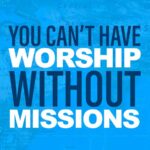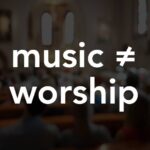This is an important question because many earnest believers desire to worship on the Lord’s Day in form and content the same way that Christ and the Apostles worshiped. The New Testament is very clear about the purpose of music for the church, but it does not give explicit indication as to what the form of church music was like. This may lead some to conclude that “style doesn’t matter,” but such a conclusion is unsatisfactory for those who believe everything in the life of a Christian matters and should fall under the lordship of Christ. Observing the role of music in early church worship, the early church’s view of pagan music, the tune of early church music, and the text of early church music will aid in understanding what musical form was like among the earliest Christians.[1]
Music’s Role in Early Church Worship
In his book Music in Early Christian Literature, James McKinnon has helpfully collected every reference to music from the extant writings of the early church fathers. A fair amount is said in the writings of the church fathers about music in general, but not much is said about music within the gathered assembly. A detailed description of what an actual worship service was like is found in the writings of Justin Martyr (c.100–c.165). This is very important because Justin was born around the same time that the Apostle John died, so Justin’s record is just one generation removed from the practice of the Apostles. In this very thorough description of a Lord’s Day meeting (read Justin’s description here), Justin describes a service as consisting of preaching, teaching, praying, reading Scripture publicly, taking of the Lord’s Table, saying “Amen,” and collecting the offering. This service is led by a pastor, with the deacons carrying out service during the week.[2] But understanding music’s place in the assembly is all the more complicated by the absence of music in this detailed description. Why would Justin omit this important aspect of worship?
The sparse references to music within the earliest writings and Justin’s omission may actually be a clue—perhaps these believers didn’t place as much emphasis on music as American churches do today. Imagine a worship service in a twenty-first-century American church with such little music that when someone described the service they might just forget to mention the music. In this same service, the Scriptures are read, to quote Justin, “as long as time permits.”[3] Such a service would be viewed as boring for Christians and ineffective for keeping “the young people engaged.” This would be unheard of, since “music” and “worship” are often used interchangeably in the modern church vocabulary.
It is not likely that Justin’s congregation never sang during Lord’s Day worship; in fact, Justin suggests that believers should “offer thanks by invocations and hymns.”[4] Justin may have associated singing so closely with the public reading of Scripture that he failed to mention the musical aspect of the service. In order to understand how Justin would have made this close association between singing Scripture and reading Scripture, the church’s use of tune and text must be understood. But before doing so, one should evaluate how the church viewed the music of pagan culture.
The Early Church’s View of Pagan Music
The early church’s view of pagan music is best seen in its abolition of instruments in worship. It is often suggested that the early church chose not to use instruments within its worship because of fear of persecution. While this theory may have some merit, it is often overstated. It seems more likely that the believers chose not to use instruments in worship because of an early polemic against pagan music and the association of instruments with pagan music. This polemic appears as early as Theophilus of Antioch (d. c.185)[5] and Tatian the Assyrian (c.120–c.180),[6] who were both agitated by the snobbery of Greek music culture. By the time of Clement of Alexandria (c.150–215), the formal opposition to pagan music was in full swing. Clement spoke of those people who sing music within the church, then sing “trash” accompanied by instruments outside the church.[7] Tertullian of Carthage (c.160–220) viewed the music of the theatre and the circus as directly connected to idolatry and bad morals.[8] Novation (d. c.258) suggested that pagan music would still be worthless even if it were not morally corrupt.[9]
The early church fathers did not see music as unredeemable and totally worthless. Cyprian of Carthage (d. 258) gives a helpful view of music: “God gave man a voice, yet amorous and indecent songs ought not to be sung; God wished iron to be used in the cultivation of the earth, not in the commission of murder; and because the Lord provided incense, wine, and fire, one must not therefore sacrifice to idols.” While music, like iron for murder and fire for idol worship, may be used for evil, it still has redeemable qualities to be used for good. The earliest Christians did not hold a “style doesn’t matter” view of music. They saw music as having moral qualities, leading men into good and evil.
The Tune of Early Church Music
Since the time of the Renaissance when the arts began rapidly changing into forms with greater complexity, church music has sought to adjust, change, and revise the text of a poem until it fits a pre-decided meter or tune. With this approach, the text becomes a slave to the tune. But this was not likely the case in the first century. While modern music adjusts the text to the tune, the music of the early church likely conformed the music to the natural rhythm and inflection of the text. Historians and musicologists have suggested that the Lord’s Day music of the early church was simple in form. It was likely monophonic (unaccompanied by instruments[10] and without harmony) and chant-like or recitative.[11] As Dickinson has observed, this is the most “restricted of all melodic styles.” Dickinson explains that for the chant of the early church, “the tones are made to conform to the meter and accent of the text, the words of which are never repeated or prosodically modified.”[12]
For today’s Christian, it’s hard to imagine such a simple form being normal. But keep in mind that tonality was not even standardized until the 1600s. The intervallic relationship of four-part harmony that the modern ear is accustomed to is only an invention of the last four hundred years. That is why the earliest hymnals (like this image from Calvin’s Geneva Psalter from the 1500s) only show one note.
This simplistic approach is not how music is treated today in the church. In the general culture, entertainers have perfected the art of lulling a crowd into a state of pleasure with music; clever marketers know just the right kind of music to manipulate consumers into buying a product. In modern pop music, words don’t really matter. Unfortunately, entertainers and marketers who know how to draw a crowd through music and atmosphere have crept into the church. In some settings, words to songs and sermons don’t really matter as long as the tried and true formula for moving a crowd is followed. The church today would be wise to take a cue from the earliest believers and seek to simplify the music of church meetings.
The Text of Early Church Music
Not only was the form of music for Lord’s Day worship restricted (to use Dickinson’s word), the content was also restricted. Considerably more material about the content of music is available since the Scriptures speak about this. The content of music for the earliest Christians was restricted to the “word of Christ” (Col. 3:16) as the believers “devoted themselves to the apostles’ teaching” (Acts 2:41–42). Personal, artistic expression that resulted in new revelation had no place in the worship of the early church (2 Peter 1:20–21). Additionally, Paul commanded that the content in the gathered meetings be intelligible (1 Cor. 14:9–12) and conducted in an orderly manner (1 Cor. 14:26–33). Many old texts and new ideas were available to these early Christians, yet they limited their content to the Scriptures.
Paul warned Timothy that a “time is coming when people will not endure sound teaching, but having itching ears they will accumulate for themselves teachers to suit their own passions, and will turn away from listening to the truth and wander off into myths” (2 Timothy 4:3-4). It was a problem in Timothy’s day and it is a problem in ours. The church is in trouble when plainly presented “sound doctrine” through modest Scripture reading, humble preaching, simple singing, and unassuming praying is not enough. Along with Paul and Timothy, may the church be resolved to limit the content of worship music (and the entire worship service) to sound doctrine presented in a simple manner.
Conclusion
By observing music’s role in early church worship, the early church’s view of pagan music, the tune of early church music, and the text of early church music this essay has sought to present a clearer view of what music was like among the earliest Christians. I am not hoping that this study will lead anyone to employ the same chant-like form of singing as the earliest Christians. The plain and simple fact is that this has not been preserved and passed down to us. I do hope this essay will cause church leaders and congregants to pause and consider a more simplified approach to worship that places emphasis on the text of Scripture. I believe it is appropriate to use recent inventions like instruments, four-part harmony, meter, and rhyme, but these inventions should not be the central focus. As the Apostle told the churches in Colossae, “Let the word of Christ dwell in you richly, teaching and admonishing one another in all wisdom, singing psalms and hymns and spiritual songs, with thankfulness in your hearts to God” (Col. 3:16).
[1] As a Baptist, I do not presume that the practice of the early church as seen in extrabiblical literature is authoritative. It is quite useful, but it is not equal to the commands given in Holy Scripture.
[2] Justin Martyr, “The First Apology of Justin,” in The Apostolic Fathers with Justin Martyr and Irenaeus, ed. Alexander Roberts, James Donaldson, and A. Cleveland Coxe, vol. 1, The Ante-Nicene Fathers (Buffalo: The Christian Literature Company, 1885), 186.
[3] Justin Martyr, “The First Apology of Justin,” 166.
[4] Justin Martyr, “The First Apology of Justin,” 186.
[5] Theophilus of Antioch, “Theophilus to Autolycus,” in Fathers of the Second Century, ed. Alexander Roberts, James Donaldson, and A. Cleveland Coxe, vol. 2, The Ante-Nicene Fathers (Buffalo: The Christian Literature Company, 1885), 106.
[6] Tatian, “Address of Tatian to the Greeks,” in Fathers of the Second Century, ed. Alexander Roberts, James Donaldson, and A. Cleveland Coxe, vol. 2, The Ante-Nicene Fathers (Buffalo: The Christian Literature Company, 1885), 65.
[7] Clement of Alexandria, “The Instructor (Paedagogus),” in Fathers of the Second Century, ed. Alexander Roberts, James Donaldson, and A. Cleveland Coxe, vol. 2, The Ante-Nicene Fathers (Buffalo: The Christian Literature Company, 1885), 290.
[8] Tertullian, “The Shows or De Spectaculis,” in Latin Christianity: Its Founder, Tertullian, ed. Alexander Roberts, James Donaldson, and A. Cleveland Coxe, vol. 3, The Ante-Nicene Fathers (Buffalo: The Christian Literature Company, 1885), 84.
[9] Novation, “De Spectaculis,” in James McKinnon, Music in Early Christian Literature (Cambridge: Cambridge University Press, 1989), 92.
[10] Ralph P. Martin, Worship in the Early Church (Grand Rapids: Wm. B. Eerdmans Publishing, 1975), 134.
[11] Edward Dickinson, Music in the History of the Western Church (New York: Haskell House Publishers LTD., 1969), 40.
[12] Dickinson, Music in the History of the Western Church, 41.








4 Responses
I enjoyed this so much, but I found one part to be a bit incorrect. I assume that you are unfamiliar with the Eastern Church worship? In your summary statement. “I am not hoping that this study will lead anyone to employ the same chant-like form of singing as the earliest Christians. The plain and simple fact is that this has not been preserved and passed down to us.”. In fact if you visit and Eastern Orthodox Church, e.g., Russian, American, Greek, etc, you can observe that it has been passed down. Please feel free to visit any Eastern Orthodox Church and experience first century worship music in the 31 Century. Many blessings to you.
PS I am a convert to the Eastern Orthodox Church after 45 years as a Southern Baptist ow which I was a deacon for 12 years.
Hello Michael, I am so glad that you’ve engaged in dialogue. Thanks for your respectful tone and THANK YOU for your faithfulness to Christ and His church for these 45+ years. I am quite familiar with the 4th-century Liturgy of St. Basil and the 5th-century Liturgy of St. John Chrysostom. These Liturgies are both artistically beautiful and theologically rich, but neither contains the 1st-century liturgy of Christ and the Apostles.
I cannot say much was added to my research by this brief article, but like with Michael, the last paragraph did stand out. To say that the Liturgy of St. Basil and of St. John Chrysostom do not contain the 1st century liturgy of Christ and the Apostles seems to be more than we can say with certainty. We may more accurately say that we do not know that they do, however, there does seem to be a good case for at least particular elements being preserved in the plainchants that were so common East and West. I just read this article from an Orthodox source http://www.asbm.goarch.org/articles/early-christian-and-byzantine-music-history-and-performance/
It gets into the connection between the Old Testament Psalms and early Church music.
SMahoney, thank you for your input. I agree with your statement here: “We may more accurately say that we do not know that they do, however, there does seem to be a good case for at least particular elements being preserved in the plainchants that were so common East and West.” I will most certainly check out this article that you’ve provided.